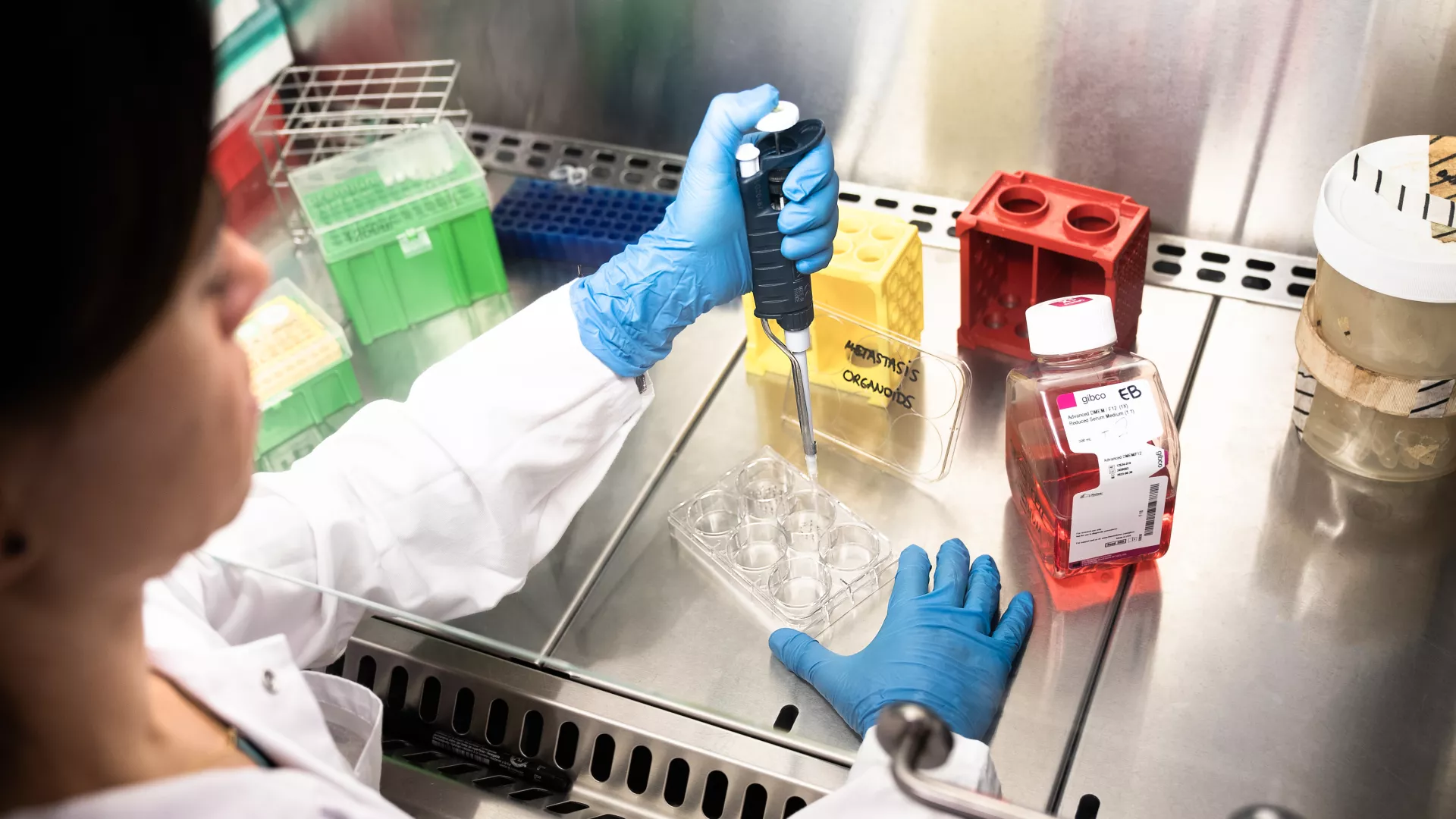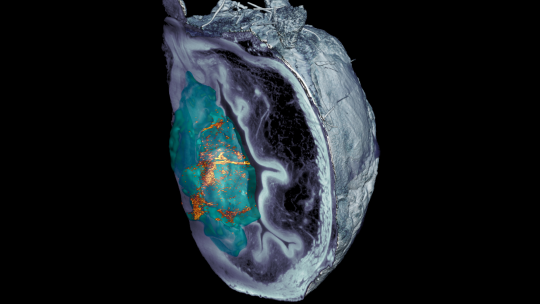Images
Participants
Contact

- IRB Barcelona has participated in a study, led by IBEC and CIC biomaGUNE, that demonstrates the effectiveness of self-propelled nanorobots in shrinking bladder tumours by 90%.
- The administration of a single dose of nanorobots leads to a significant reduction in tumour volume, opening the door to more efficient and less invasive treatments for bladder cancer.
- IRB Barcelona's Advanced Digital Microscopy Facility has developed innovative, tailored technology that allows nanorobots to be visualised without prior markers. This achievement thus reflects the excellence of the Institute's scientific platforms.
Researchers from the Institute for Bioengineering of Catalonia (IBEC) and the CIC biomaGUNE, in collaboration with IRB Barcelona and the Autonomous University of Barcelona (UAB), have managed to reduce the size of bladder tumours in mice by 90% through the use of self-propelled nanorobots. The study, published in the prestigious journal Nature Nanotechnology, offers a promising solution for bladder cancer.
The contribution of IRB Barcelona's Advanced Digital Microscopy Facility has been key to the project. Innovating in bioimaging techniques, they developed an optical system that allowed the visualisation and localisation of nanorobots inside the bladder without the need for prior markers and at an unprecedented resolution. Julien Colombelli, manager of the platform, highlights the importance of this advance: "Only then did we see that the nanorobots not only reached the tumour but also managed to enter it, thus enhancing the action of the radiopharmaceutical."
This work exemplifies the importance of excellent scientific platforms and cutting-edge technology to advance frontier science and advance the understanding and treatment of diseases.
Bladder cancer in context
Bladder cancer has one of the highest incidence rates in the world and ranks as the fourth most common tumour in men. Despite its relatively low mortality rate, nearly half of bladder tumours resurface within 5 years. Patients thus require ongoing follow-up, frequent hospital appointments and repeated treatments, thus making bladder cancer one of the most costly types of cancer to cure.
Current treatments that involve administering drugs directly into the bladder have demonstrated good survival rates but low therapeutic efficacy. A promising alternative is the use of nanoparticles capable of delivering the therapeutic agent directly to the tumour. In particular, nanorobots—nanoparticles with the ability to self-propel inside the body—stand out.
Nanorobots propelled by urea
To tackle the challenge posed by bladder cancer, the team of researchers has developed tiny nanomachines that are powered by urea present in urine and specifically target the tumour, attacking it with a radioisotope carried on their surface. These nanomachines are made up of a porous silica sphere and their surface carries various components with specific functions. One of them is the enzyme urease, a protein that reacts with urea, present in urine, making the nanoparticle capable of propelling itself. Another key component is radioactive iodine, a radioisotope commonly used for the localised treatment of tumours.
This work paves the way for new treatments for bladder cancer that reduce the length of hospitalisation, thereby implying lower costs and greater comfort for patients.
“With a single dose, we observed a 90% decrease in tumour volume. This is significantly more efficient than current treatments, given that patients with this type of tumour typically have between 6 and 14 hospital appointments. This therapeutic approach would increase efficiency by reducing the length of hospitalisations and the cost of the treatment,” explains Samuel Sánchez, ICREA research professor at IBEC and leader of the study.
The next step, which the team is already working on, is to determine whether these tumours recur after treatment.
Technological innovation in microscopy to locate the nanorobots
Working with nanorobots has posed a significant scientific challenge with regard to bioimaging techniques to visualise these devices in tissues and the tumour itself. Common non-invasive clinical techniques, like PET, lack the resolution necessary to locate these very small particles at the microscopic level.
To address this, IRB Barcelona's Advanced Digital Microscopy Facility developed a technique that involves the use of a sheet of laser light to illuminate the samples, allowing the acquisition of 3D images through light scattering upon interaction with tissues and particles. Upon observation that the tumour itself scattered part of the light, causing interference, the facility team developed a new technique based on polarised light that cancels out all scattering from the tumour tissue and cells. This approach allows the visualisation and location of the nanorobots without the need for prior tagging with molecular methods.
The potential of technology at IRB Barcelona
IRB Barcelona has 9 core facilities, ranging from cutting-edge technologies such as microscopy, drug screening, genomics or proteomics, and essential services such as bioinformatics, protein expression and Drosophila injection, to unique platforms for the generation of genetically modified mouse models or histopathology. All these facilities play a key role in pushing the limits of frontier science. The advanced technologies and talented experienced personnel who staff the facilities strengthen interdisciplinary collaboration and are fundamental pillars for innovative research.
By providing specialised equipment and an environment that lends itself to innovation, these facilities make a significant contribution to the development of new techniques and the advancement of biomedical research, thereby strengthening the capacity of the Institute to address complex challenges.
Related article:
Radionuclide therapy with accumulated urease-powered nanobots reduces bladder tumor size in an orthotopic murine model
Cristina Simó, Meritxell Serra-Casablancas, Ana C. Hortelao, Valerio Di Carlo, Sandra Guallar-Garrido, Sandra Plaza-García, Rosa Maria Rabanal, Pedro Ramos-Cabrer, Balbino Yagüe, Laura Aguado, Lídia Bardia, Sébastien Tosi, Vanessa Gómez-Vallejo, Abraham Martín, Tania Patiño, Esther Julián, Julien Colombelli, Jordi Llop, Samuel Sánchez
Nature Nanotechnology (2024). DOI: 10.1038/s41565-023-01577-y
About IRB Barcelona
The Institute for Research in Biomedicine (IRB Barcelona) pursues a society free of disease. To this end, it conducts multidisciplinary research of excellence to cure cancer and other diseases linked to ageing. It establishes technology transfer agreements with the pharmaceutical industry and major hospitals to bring research results closer to society, and organises a range of science outreach activities to engage the public in an open dialogue. IRB Barcelona is an international centre that hosts 400 researchers and more than 30 nationalities. Recognised as a Severo Ochoa Centre of Excellence since 2011, IRB Barcelona is a CERCA centre and member of the Barcelona Institute of Science and Technology (BIST).




